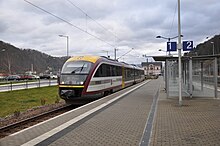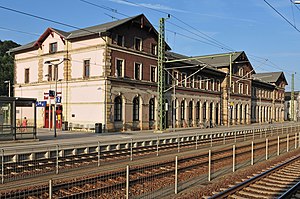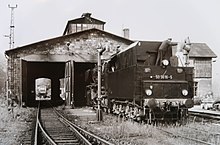Bad Schandau train station
| Bad Schandau | |
|---|---|
|
Station building, track side
|
|
| Data | |
| Operating point type | railway station |
| Location in the network | Separation station |
| Platform tracks | 4th |
| abbreviation | DSA |
| IBNR | 8010022 |
| opening | July 1, 1877 |
| Profile on Bahnhof.de | Bad Schandau |
| location | |
| City / municipality | Bad Schandau |
| country | Saxony |
| Country | Germany |
| Coordinates | 50 ° 55 '9 " N , 14 ° 8' 14" E |
| Height ( SO ) | 126 m |
| Railway lines | |
|
|
| Railway stations and stops in Saxony | |
The Bad Schandau station is an operating point of the Děčín – Dresden-Neustadt railway and the Bautzen – Bad Schandau railway line that joins here in the municipality of Bad Schandau in Saxony . Bad Schandau is a border station for international traffic between Germany and the Czech Republic .
Today, Bad Schandau station is the only long-distance traffic stop in the Saxon Switzerland national park region . It is marketed as a "National Park Station" by Deutsche Bahn and the city of Bad Schandau.
history
Development until 1945
Bad Schandau got its rail connection with the construction of the Saxon-Bohemian Railway, the Königstein – Krippen section of which was opened on June 9, 1850. Almost a year later, on April 6, 1851, the last section from cribs to the state border was released and the continuous railway line from Dresden to Prague opened. At that time, today's Krippen stop was the train station for the city of Schandau .
In connection with the construction of the Bautzen – Bad Schandau railway line and the strong growth in traffic, a new building was built at the current location, which was named Bahnhof Schandau when it opened in 1877 . It has had its current name since July 1920.
In 1920 the station was rebuilt and expanded. In this context, he received a new depot and additional track systems. The station was of particular importance for local freight and passenger traffic, but also for the numerous tourists who visited the region. In 1945 the second track and parts of the track system were dismantled as reparations to the Soviet Union.
Development after 1945

The signing of the provisional agreement on the implementation of reciprocal rail traffic for the Prostřední Žleb – Bad Schandau border crossing on August 31, 1947 with this arrangement between the Czechoslovak State Railways (ČSD) and the Deutsche Reichsbahn (DR ) the handover and takeover of all cross-border trains in Bad Schandau was agreed and the station thus becomes the border station. From then on, controls in cross-border goods and passenger traffic were carried out here.
There were extensive changes in connection with the electrification of the railway line from 1970 to 1976. In addition to changes to the track systems, a modern central signal box was built . The old signal boxes were demolished in the following years. In addition, the road to Krippen was re-routed, a modern road bridge was built over the Elbe and, in this context, two new overpasses built over the station area.
On October 22, 1980, a fire in the attic severely damaged the station building. In July 1981 the goods shed burned down.
When more and more citizens tried to leave the GDR via Czechoslovakia before the fall of the Wall in 1989 , the Ministry of State Security ordered “suspicious” travelers to disembark from trains heading for ČSSR in Bad Schandau near the border , have them checked and, if necessary, sent back.
Even after the fall of the Berlin Wall, Bad Schandau station initially retained its importance in freight traffic. In the mid-1990s, however, there was a significant decline, especially in freight traffic, which got worse after the merger of the Deutsche Reichsbahn and Bundesbahn to form Deutsche Bahn AG. This development led to a significant reduction in shunting trips and thus also the use of the existing sidings, so that some of these were also demolished.
In the years 2008 to 2011, the station and the reception building, which has been owned by the City of Bad Schandau since 2010, were completely renovated. Since then there has been a tourist information office, an organic market and barrier-free platforms. In addition, parking spaces for cars and bicycles as well as transfer options to buses and ferries have been created. The station was named Station of the Year 2012 (Special Prize for Tourism) by the Pro-Rail Alliance .
In 2012, around 1,600 travelers and visitors were counted at the station every day. 94 trains stopped daily.
Bad Schandau depot
A simple sandstone boiler house was also built when the station was built . In the 1920s a turntable was built and the boiler house was enlarged. The Bad Schandau depot was founded in 1925 .

On December 31, 1963, the depot was dissolved as an independent department and subordinated to the Pirna depot . In 1994 the site was closed. In the 2000s, all the facilities were demolished.
Traffic significance
Bad Schandau station is served by Eurocity trains on the Berlin – Prague route, some of which go through to Hamburg or Budapest. In local transport, the trains of the Dresden S-Bahn line S1 (Schöna – Meißen-Triebischtal), which run every half hour, dominate. The regional trains of the U28 line (Děčín – Rumburk) pass the station every two hours, supplemented by the RE20 line (Dresden Hbf – Litoměřice město), which runs seasonally.
literature
- Johannes Raddatz: Railway in Saxon Switzerland - Volume 3. Bad Schandau station - the most important border station of the former GDR in the direction of Southeast Europe and the Bad Schandau depot. The train stations Krippen, Bad Schandau Ost and Schöna. The electrification of the Schöna – Dresden line and in cross-border traffic. The line between the state border and Bodenbach and the Bodenbach and Tetschen stations , Verlag B. Neddermeyer, Berlin 2011, ISBN 978-3-941712-17-1
Web links
- Representation of the track system as well as some signals and permissible speeds on the OpenRailwayMap
- Detailed description of the history and facilities of the station
Individual evidence
- ↑ a b Alliance pro Schiene : Station of the Year: Special Tourism Prize 2012: Bad Schandau Station (PDF; 145 kB)
- ↑ a b Kurt Kaiß, Matthias Hengst: Dresdens Eisenbahn - 1894–1993 , Alba-Verlag, Düsseldorf 1994, ISBN 3-87094-350-5 , p. 138
- ↑ a b Sebnitztalbahn.de: Bad Schandau Station
- ↑ Johannes Raddatz: Railway in Saxon Switzerland - Volume 3 , p. 59 ff.
- ↑ Michael Richter : The Peaceful Revolution - Departure for Democracy in Saxony 1989/90, 2010, p. 256 ff .; Heiner Timmermann (Ed.): The GDR - Analyzes of an Abandoned State , 2001, p. 223; Heiner Timmermann: The GDR between the building of the wall and the fall of the wall , 2nd edition 2012, p. 356 with further references.
- ↑ Tourist information of the city of Bad Schandau in the train station
- ^ Press release from Deutsche Bahn ( memento of December 10, 2012 in the Internet Archive ) on the 2012 special award
- ↑ Allianz pro Schiene (ed.): The winner's plaque adorns the citizens' station . Press release from September 10, 2012.
- ^ Klaus-Jürgen Kühne: Bahnbetriebswerke der GDR - 1949-1993 , transpress-Verlag, Stuttgart 2011, ISBN 978-3-613-71401-4 , p. 12


